New Procedure for Compacting Prismatic Specimens of Cement-Treated Base Materials
Abstract
:1. Introduction
- Environmental and economical advantages associated with the employment of soils coming from areas close to the outline of the road, decreasing the consumption of quarry aggregates and the necessity of landfills and, hence, reducing emissions to the atmosphere.
- Technical advantages related to the high resistance of the material, which allows the prolonging of pavement life and a reduction in maintenance costs.
- As disadvantage, it must be underlined that this technique requires precision when carrying it out. Variations in the layer thickness, cement percentage or density modify its properties. Moreover, it needs a pre-cracking process to increase the material life.
2. Description of the Device and New Methodology for Compacting Prismatic Specimens of Cement-Treated Base Materials
- Fixing the entire device. It is necessary to fix the removable base of the metallic mould to the vibrating table by means of the metal gripping elements and stiffeners. The metal stand that takes the metal sheets is guided by means of a metallic collar.
- Preparation of the mould, extension of the first layer of material, and compaction. In order to avoid adherence of the material to the mould, it is necessary to apply a mould-release agent in the interior faces of the mould. Depending on the maximum aggregate size, specimens can be manufactured in 2 or 3 layers, depending on the compaction of the material. As a general rule, the solution with the minimum number of layers that allow achieving the maximum dry density required in the standards will be selected. After spreading the first layer of material, the metal stand is placed above it with 3 or 4 metallic sheets. The vibration table is switched on and the vibration is transmitted for 15 or 20 s.
- Extension and compaction of the second layer. After the first layer is vibrated, the metal stand and the metal sheets are extracted and the second layer is spread over the first one, which is already compacted. Once again, the stand and the sheets are placed over the material and this layer is vibrated for the same period as in the first layer.
- Extension and compaction of the third layer. In case a third layer is needed in order to obtain the required compaction density, a third layer is spread over the previous ones and is vibrated for the same period as in step 2.
- Extraction of the stand, dismantling the collar, and finishing the specimen. After the compaction of the last layer, the metal stand is extracted, the metallic collar is dismantled and excess material in the specimen is removed by means of a scraper.
- Removing the mould from the vibrating table. The mould is uncoupled from the gripping elements and stiffeners and the metal mould is removed from the vibrating table.
- Determination of the dry density of the manufactured specimen. The metal mould, containing the humid compacted mixture, is weighed and the dry density of the sample is calculated.
3. Material Employed and Proposed Methodology for Verification of the Procedure
3.1. Description of Material Employed
3.2. Methodology for Verifying the Proposed Compacting Procedure
4. Results and Discussion
4.1. Results from the Compaction Procedure (First Experiment)
4.2. Results from Tests on the Manufactured Prismatic Samples
4.3. Comparison of the Long-Term Flexural Strength (FS) and Long-Term Unconfined Compressive Strength (UCS) Results with those Proposed by Other Authors
5. Conclusions
- The percentage of the modified Proctor density achieved is equal to or above 98%, which is established as the minimum for this material by the Spanish standard [43]. The particularity of the proposed iterative procedure is that, apart from being effective for this type of mixing (for the soil-cement), it is also useful for any kind of prismatic sample of cement-treated material.
- The improvement of the workability and compaction of the prismatic specimens could require the moisture content to be above that which the maximum dry density indicates, according to the modified Proctor compaction procedure. This conclusion could be extracted from the material employed but it would need a further analysis of the iterative process with a different material.
- Differences over 3% on the modified Proctor densities in specimens from the same batch leads to differences in the FS and UCS, which means they can be considered as dissimilar. Therefore, they must be rejected for tests that compare their results. This percentage could be used as a reference value for other CTM.
- The long-term FS and UCS results for this mixture were usual for this kind of base material (UCS around 4 MPa and FS around 0.9 MPa at 90 days). Hence, the validity of the experimental method presented here is confirmed.
Author Contributions
Funding
Conflicts of Interest
References
- Bell, F.G. Engineering Treatment of Soils; E & FN Spon: London, UK, 1993. [Google Scholar]
- IECA-CEDEX. Manual de Firmes con Capas Tratadas con Cemento, 2nd ed.; Centro de Estudios y Experimentación de Obras Públicas (CEDEX): Madrid, France, 2003; p. 265. [Google Scholar]
- Disfani, M.M.; Arulrajah, A.; Haghighi, H.; Mohammadinia, A.; Horpibulsuk, S. Flexural beam fatigue strength evaluation of crushed brick as a supplementary material in cement stabilized recycled concrete aggregates. Constr. Build. Mater. 2014, 68, 667–676. [Google Scholar] [CrossRef]
- Hou, Y.; Ji, X.; Su, X. Mechanical properties and strength criteria of cement-stabilised recycled concrete aggregate. Int. J. Pavement Eng. 2017, 1–10. [Google Scholar] [CrossRef]
- Nunes, M.C.M.; Bridges, M.G.; Dawson, A.R. Assessment of secondary materials for pavement construction: Technical and environmental aspects. Waste Manag. 1996, 16, 87–96. [Google Scholar] [CrossRef]
- Poon, C.S.; Chan, D. Feasible use of recycled concrete aggregates and crushed clay brick as unbound road sub-base. Constr. Build. Mater. 2006, 20, 578–585. [Google Scholar] [CrossRef]
- Akbulut, H.; Gürer, C. Use of aggregates produced from marble quarry waste in asphalt pavements. Build. Environ. 2007, 42, 1921–1930. [Google Scholar] [CrossRef]
- Arulrajah, A.; Ali, M.M.Y.; Piratheepan, J.; Bo, M.W.M.A. Geotechnical Properties of Waste Excavation Rock in Pavement Subbase Applications. J. Mater. Civ. Eng. 2012, 24, 924–932. [Google Scholar] [CrossRef]
- Tahmoorian, F.; Samali, B.; Tam, V.; Yeaman, J. Evaluation of Mechanical Properties of Recycled Material for Utilization in Asphalt Mixtures. Appl. Sci. 2017, 7, 763. [Google Scholar] [CrossRef]
- Jullien, A.; Proust, C.; Martaud, T.; Rayssac, E.; Ropert, C. Variability in the environmental impacts of aggregate production. Resour. Conserv. Recycl. 2012, 62, 1–13. [Google Scholar] [CrossRef] [Green Version]
- Magnusson, S.; Lundberg, K.; Svedberg, B.; Knutsson, S. Sustainable management of excavated soil and rock in urban areas—A literature review. J. Clean. Prod. 2015, 93, 18–25. [Google Scholar] [CrossRef]
- Mathieu, P.; Pierre, H.; Olivier, C.; Thomas, L. Use of Treated Soils for Sustainable Rail Infrastructures. Procedia Soc. Behav. Sci. 2012, 48, 276–286. [Google Scholar] [CrossRef]
- Jayasinghe, C.; Mallawaarachchi, R.S. Flexural strength of compressed stabilized earth masonry materials. Mater. Des. 2009, 30, 3859–3868. [Google Scholar] [CrossRef]
- Aymerich, F.; Fenu, L.; Francesconi, L.; Meloni, P. Fracture behaviour of a fibre reinforced earthen material under static and impact flexural loading. Constr. Build. Mater. 2016, 109, 109–119. [Google Scholar] [CrossRef]
- Jayasinghe, C.; Fonseka, W.M.C.D.J.; Abeygunawardhene, Y.M. Load bearing properties of composite masonry constructed with recycled building demolition waste and cement stabilized rammed earth. Constr. Build. Mater. 2016, 102 Pt 1, 471–477. [Google Scholar] [CrossRef]
- Adaska, W.S. ACI Committee 230 1R-90. State-of-the-art report on soil-cement. Mater. J. 1997, 87, 395–417. [Google Scholar] [CrossRef]
- Baghini, M.S.; Ismail, A.; Firoozi, A.A. Physical and Mechanical Properties of Carboxylated Styrene-butadiene Emulsion Modified Portland Cement Used in Road Base Construction. J. Appl. Sci. 2016, 16, 344–358. [Google Scholar] [CrossRef]
- Lv, S.; Liu, C.; Lan, J.; Zhang, H.; Zheng, J.; You, Z. Fatigue Equation of Cement-Treated Aggregate Base Materials under a True Stress Ratio. Appl. Sci. 2018, 8, 691. [Google Scholar] [CrossRef]
- Ismail, A.; Baghini, M.S.; Karim, M.R.; Shokri, F.; Al-Mansob, R.A.; Firoozi, A.A.; Firoozi, A.A. Laboratory Investigation on the Strength Characteristics of Cement-Treated Base. AMM Appl. Mech. Mater. 2014, 507, 353–360. [Google Scholar] [CrossRef]
- Francois, A.; Ali, A.; Mehta, Y. Evaluating the impact of different types of stabilised bases on the overall performance of flexible pavements. Int. J. Pavement Eng. 2017, 1–9. [Google Scholar] [CrossRef]
- Brown, S.F. Design of pavements with lean-concrete bases. Transp. Res. Rec. 1979, 725, 51–58. [Google Scholar]
- Williams, R.I.T. Cement-Treated Pavements: Materials, Design and Construction; Elsevier Applied Science Publishers: London, UK, 1986; Volume XIX, 746p. [Google Scholar]
- Xuan, D.X.; Houben, L.J.M.; Molenaar, A.A.A.; Shui, Z.H. Mechanical properties of cement-treated aggregate material—A review. Mater. Des. 2012, 33, 496–502. [Google Scholar] [CrossRef]
- Papadopoulos, E.; Santamarina, J.C. Inverted base pavements: Construction and performance. Int. J. Pavement Eng. 2017, 1–7. [Google Scholar] [CrossRef]
- Kolias, S.; Williams, R.I.T. Cement-Bound Road Materials: Strength and Elastic Properties Measured in the Laboratory; Report SR 344; Transport and Road Research Laboratory: Crowthorne, UK, 1978. [Google Scholar]
- Otte, E. A structural Design Procedure for Cement-Treated Layers in Pavements; Faculty of Engineering, University of Pretoria: Pretoria, South Africa, 1978. [Google Scholar]
- Austroads. Publication No. AP–T101/08. The Development and Evaluation of Protocols for the Laboratory Characterisation of Cemented Materials; Austroads: Sydney, Australia, 2008. [Google Scholar]
- Díaz, J. El Estudio de Comportamiento de los Firmes Reciclados In Situ con Cemento. Ph.D. Thesis, Universidad de Burgos (España), Burgos, Spain, 2011. [Google Scholar]
- Han, Y.J.; Oh, S.K.; Kim, B. Effect of Load Transfer Section to Toughness for Steel Fiber-Reinforced Concrete. Appl. Sci. 2017, 7, 549. [Google Scholar] [CrossRef]
- Mansoor, J.; Shah, S.; Khan, M.; Sadiq, A.; Anwar, M.; Siddiq, M.; Ahmad, H. Analysis of Mechanical Properties of Self Compacted Concrete by Partial Replacement of Cement with Industrial Wastes under Elevated Temperature. Appl. Sci. 2018, 8, 364. [Google Scholar] [CrossRef]
- Reeder, G.D.; Harrington, D.; Ayers, M.E.; Adaska, W.S. Guide to Full-Depth Reclamation (FDR) with Cement; National Concrete Pavement Technology Center, Institute for Transportation of Iowa State University: Ames, IA, USA; Portland Cement Association: Washington, DC, USA, 2017. [Google Scholar]
- ASTM. D1632-17: Standard Practice for Making and Curing Soil-Cement Compression and Flexure Test Specimens in the Laboratory; American Society for Testing and Materials International (ASTM): West Conshohocken, PA, USA, 2017. [Google Scholar]
- Kersten, M.S. Soil Stabilization with Portland Cement; National Academy of Sciences-National Research Council: Washington, DC, USA, 1961. [Google Scholar]
- Thompson, M.R. Mechanistic Design Concepts for Stabilized Base Pavements; Department of Transportation Federal Highway Administration, University of Illinois: Champaign, IL, USA, 1986. [Google Scholar]
- Lim, S.; Zollinger, D.G. Estimation of the compressive strength and modulus of elasticity of cement-treated aggregate base materials. Transp. Res. Rec. 2003, 1837, 30–38. [Google Scholar] [CrossRef]
- Vicente, M.A.; González, D.C.; Gonzalo-Orden, H.; Linares, A. Procedimiento y Dispositivo para la Compactación de Probetas Prismáticas para la Caracterización de Materiales Granulares Tratados con Conglomerantes Hidráulicos Para su uso en Carreteras; Número de Publicación: 2394801; Oficina Española de Patentes y Marcas (OEPM): Madrid, Spain, 2014. [Google Scholar]
- Díaz, J.; Linares, A.; González, D.; Gonzalo-Orden, H. In situ pavement recycling with cement design. In Proceedings of the 4th European Pavement and Asset Management Conference (EPAM), Malmö, Sweden, 5–7 September 2012. [Google Scholar]
- Díaz, J.; Gonzalo-Orden, H.; González, D.; Linares, A. Behavior pavement recycling with cement. In Proceedings of the 12th International Symposium on Concrete Roads, Prague, Czech Republic, 23–26 September 2014. [Google Scholar]
- Linares, A. Metodología Para el Avance en la Caracterización del Suelocemento de Aplicación en Firmes Semirrígidos. Ph.D. Thesis, Universidad de Burgos, Burgos, Spain, 2015. [Google Scholar]
- Arnold, G.; Morkel, C.; Westhuizen, G. Development of Tensile Fatigue Criteria for Bound Materials; Research Report 463; NZ Transport Agency: Wellington, New Zealand, 2011.
- Bejan, S.; Pérez-Acebo, H. Modeling the Dynamic Interaction between a Vibratory-Compactor and Ground. Rom. J. Acoust. Vib. 2016, 12, 94–97. [Google Scholar]
- AENOR. Norma UNE 103.101 Análisis Granulométrico de Suelos por Tamizado; Asociación Española de Normalización y Certificación (AENOR): Madrid, Spain, 1995. [Google Scholar]
- MFOM. Pliego de Prescripciones Técnicas Generales para Obras de Carretera y Puentes (PG-3); Ministerio De Fomento: Madrid, Spain, 2015. [Google Scholar]
- ASTM. D4318-17: Standard Test Methods for Liquid Limit, Plastic Limit, and Plasticity Index of Soils; American Society for Testing and Materials International (ASTM): West Conshohocken, PA, USA, 2017. [Google Scholar]
- ASTM. D2419-14: Standard Test Method for Sand Equivalent Value of Soils and Fine Aggregate; American Society for Testing and Materials International (ASTM): West Conshohocken, PA, USA, 2014. [Google Scholar]
- ASTM. D2487-11: Standard Practice for Classification of Soils for Engineering Purposes (Unified Soil Classification System); American Society for Testing and Materials International (ASTM): West Conshohocken, PA, USA, 2011. [Google Scholar]
- ASTM. D2974-14: Standard Test Methods for Moisture, Ash, and Organic Matter of Peat and Other Organic Soils; American Society for Testing and Materials International (ASTM): West Conshohocken, PA, USA, 2014. [Google Scholar]
- ASTM. C1580-15: Standard Test Method for Water-Soluble Sulfate in Soil; American Society for Testing and Materials International (ASTM): West Conshohocken, PA, USA, USA, 2014. [Google Scholar]
- AENOR. UNE 103-501-94: Geotecnia: Ensayo de Compactación Proctor Modificado; Asociación Española de Normalización y Certificación (AENOR): Madrid, Spain, 1994. [Google Scholar]
- ASTM. D1557-12e1: Standard Test Methods for Laboratory Compaction Characteristics of Soil Using Modified Effort (56,000 ftlbf/ft3 (2700 kN-m/m3)); American Society for Testing and Materials International (ASTM): West Conshohocken, PA, USA, 2012. [Google Scholar]
- BS. BS-1924-1: Stabilized Materials for Civil Engineering Purposes. General Requirements, Sampling, Sample Preparation and Tests on Materials Before Stabilization; British Standards Institution: London, UK, 1990. [Google Scholar]
- TMR. Technical Standard MRTS08 Plant-Mixed Stabilised Pavements Using Cement or Cementitious Blends: Transport and Main Roads Specifications; Department of Transport and Main Roads: Spring Hill, Australia, 2010.
- CCANZ. IB-89. Cement Stabilisation; Cement and Concrete Association of New Zealand: Wellington, New Zealand, 2008. [Google Scholar]
- Molenaar, A.A.A. Road Materials-Part II: Soil Stabilization (Lecture CT4850); Delft University of Technology: Delft, The Netherlands, 1998. [Google Scholar]
- MOC. JTJ034-2000: Technical Specifications for Construction of Highway Road Bases; Ministry of Communications of the People’s Republic of China: Beijing, China, 2000.
- AENOR. UNE-EN 12390-1: Parte 1: Forma, Medidas y Otras Características; Asociación Española de Normalización y Certificación (AENOR): Madrid, Spain, 2013. [Google Scholar]
- ASTM. D1634-00: Standard Test Method for Compressive Strength of Soil-Cement Using Portions of Beams Broken in Flexure (Modified Cube Method) (Withdrawn 2015); American Society for Testing and Materials International (ASTM): West Conshohocken, PA, USA, 2006. [Google Scholar]
- AENOR. UNE-EN 12390-2. Parte 2: Fabricación y Curado de Probetas para Ensayos de Resistencia; Asociación Española de Normalización y Certificación (AENOR): Madrid, Spain, 2009. [Google Scholar]
- ASTM. D1635/D1635M-12: Standard Test Method for Flexural Strength of Soil-Cement Using Simple Beam with Third-Point Loading; American Society for Testing and Materials International (ASTM): West Conshohocken, PA, USA, 2012. [Google Scholar]
- AENOR. UNE-EN 12390-5. Parte 5: Resistencia a Flexión de Probetas; Asociación Española de Normalización y Certificación (AENOR): Madrid, Spain, 2009. [Google Scholar]
- CEDEX. Norma NLT-305/90. Resistencia a Compresión Simple de Materiales Tratados con Conglomerantes Hidráulicos; CEDEX, Dirección General de Carreteras, Ministerio de Fomento: Madrid, Spain, 1990. [Google Scholar]
- Hong, S. Influence of Curing Conditions on the Strength Properties of Polysulfide Polymer Concrete. Appl. Sci. 2017, 7, 833. [Google Scholar] [CrossRef]
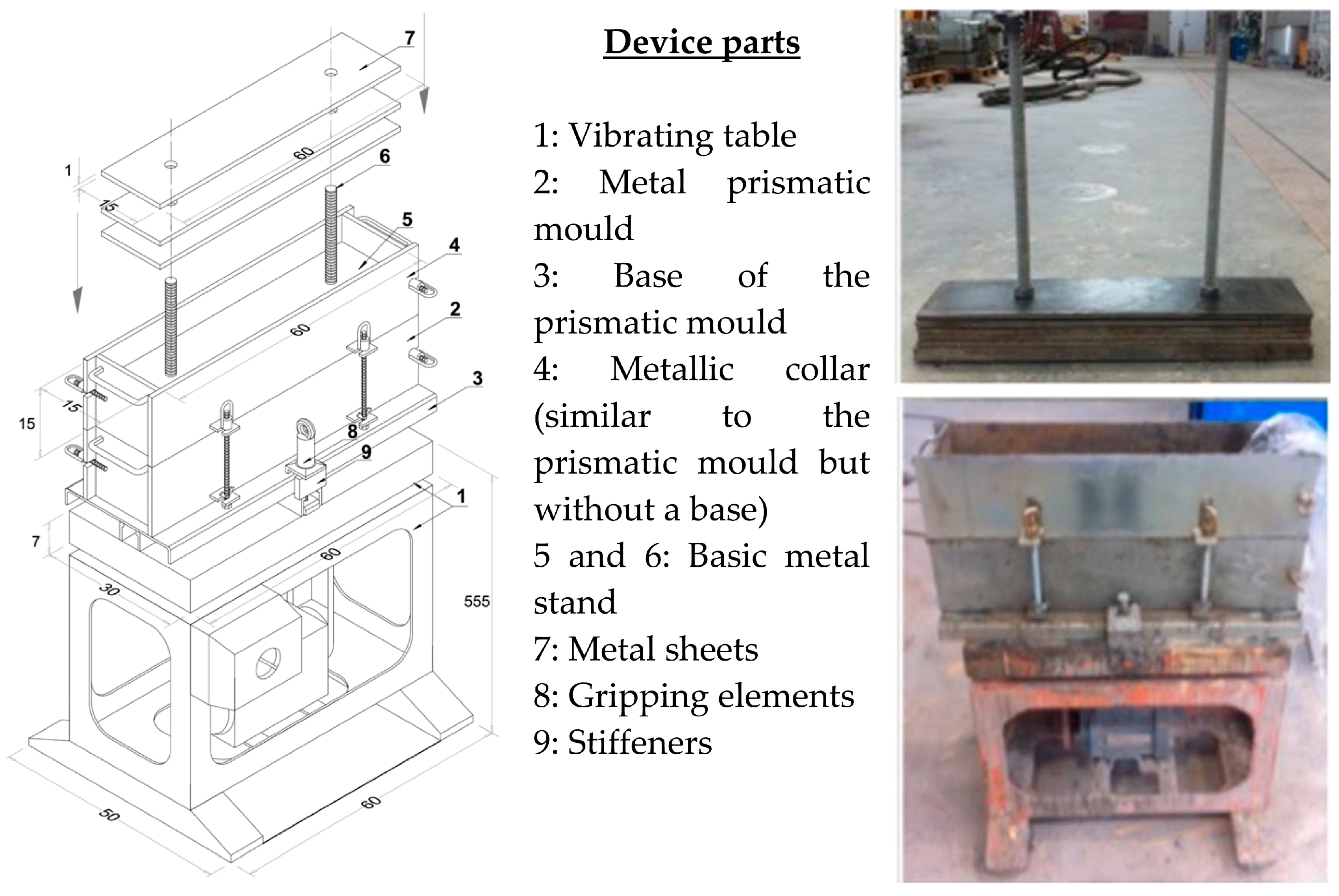
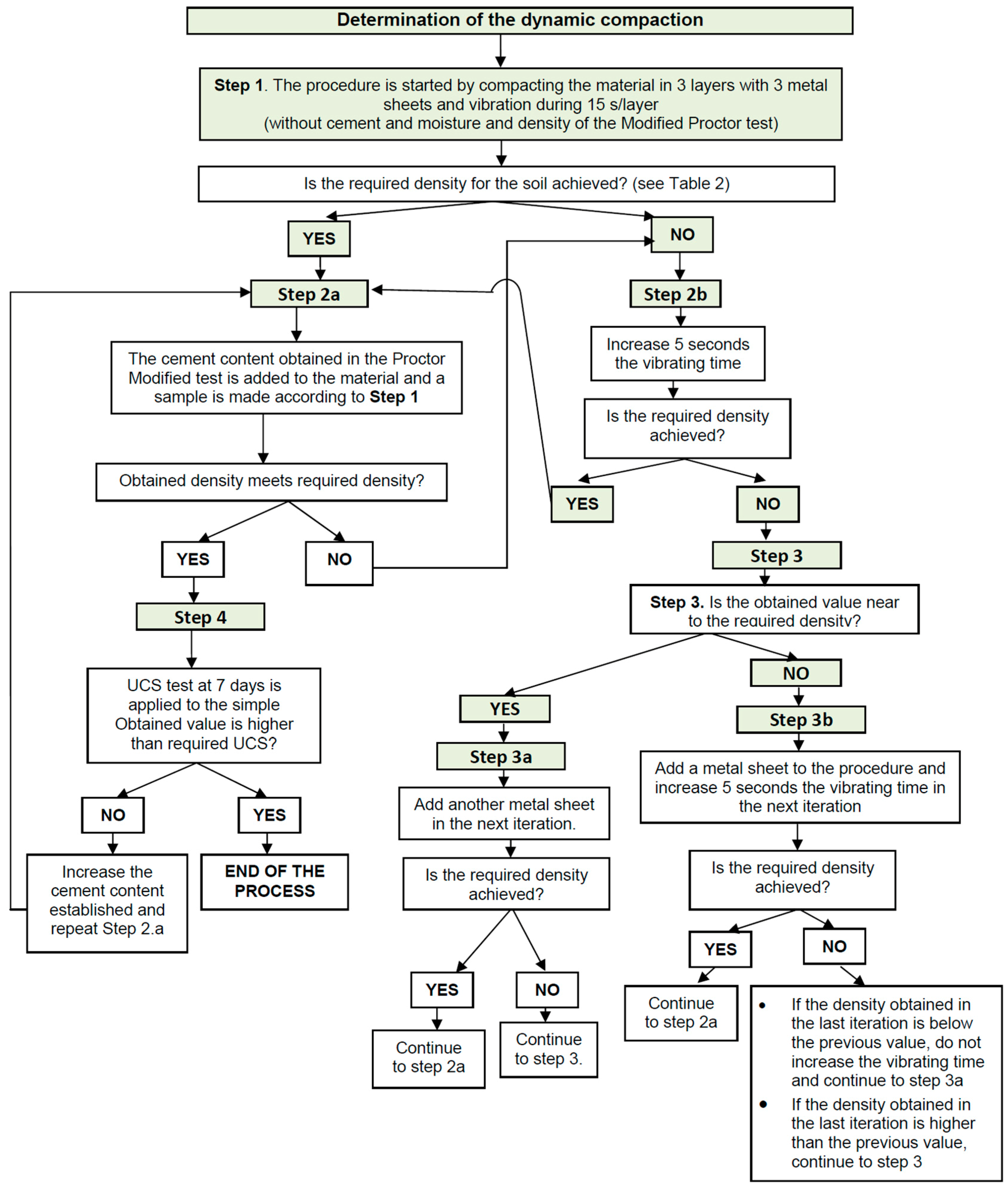
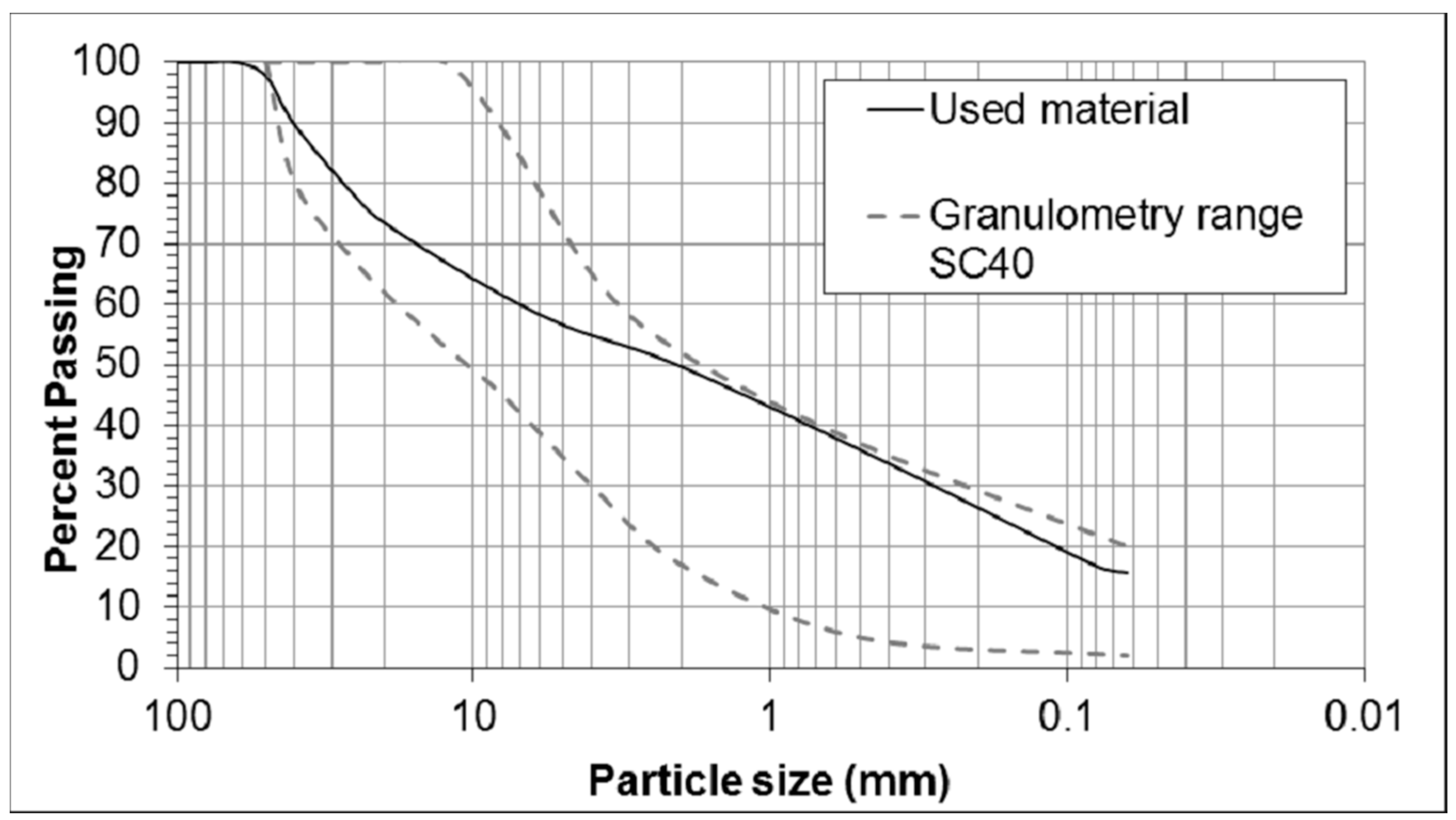
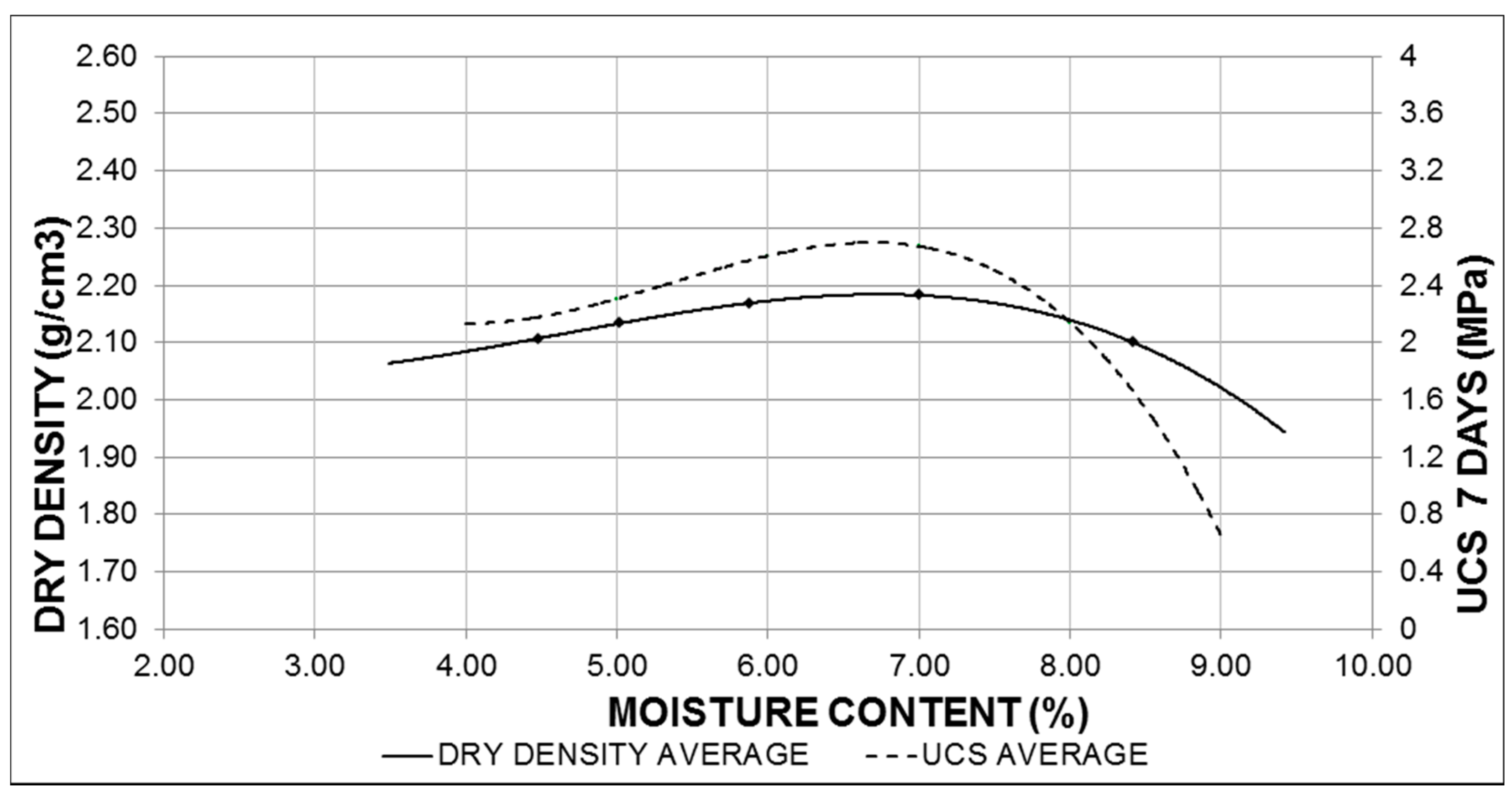
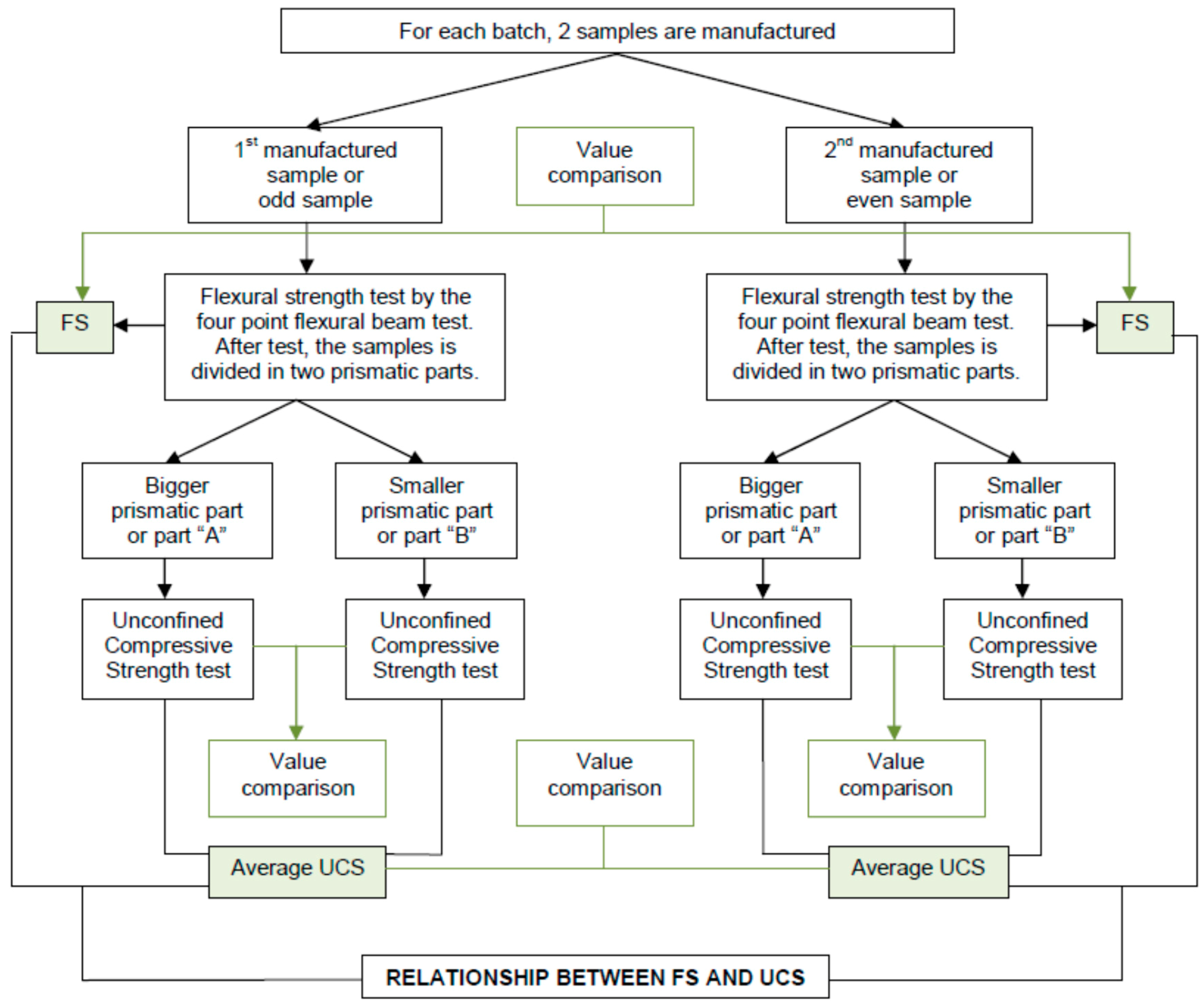
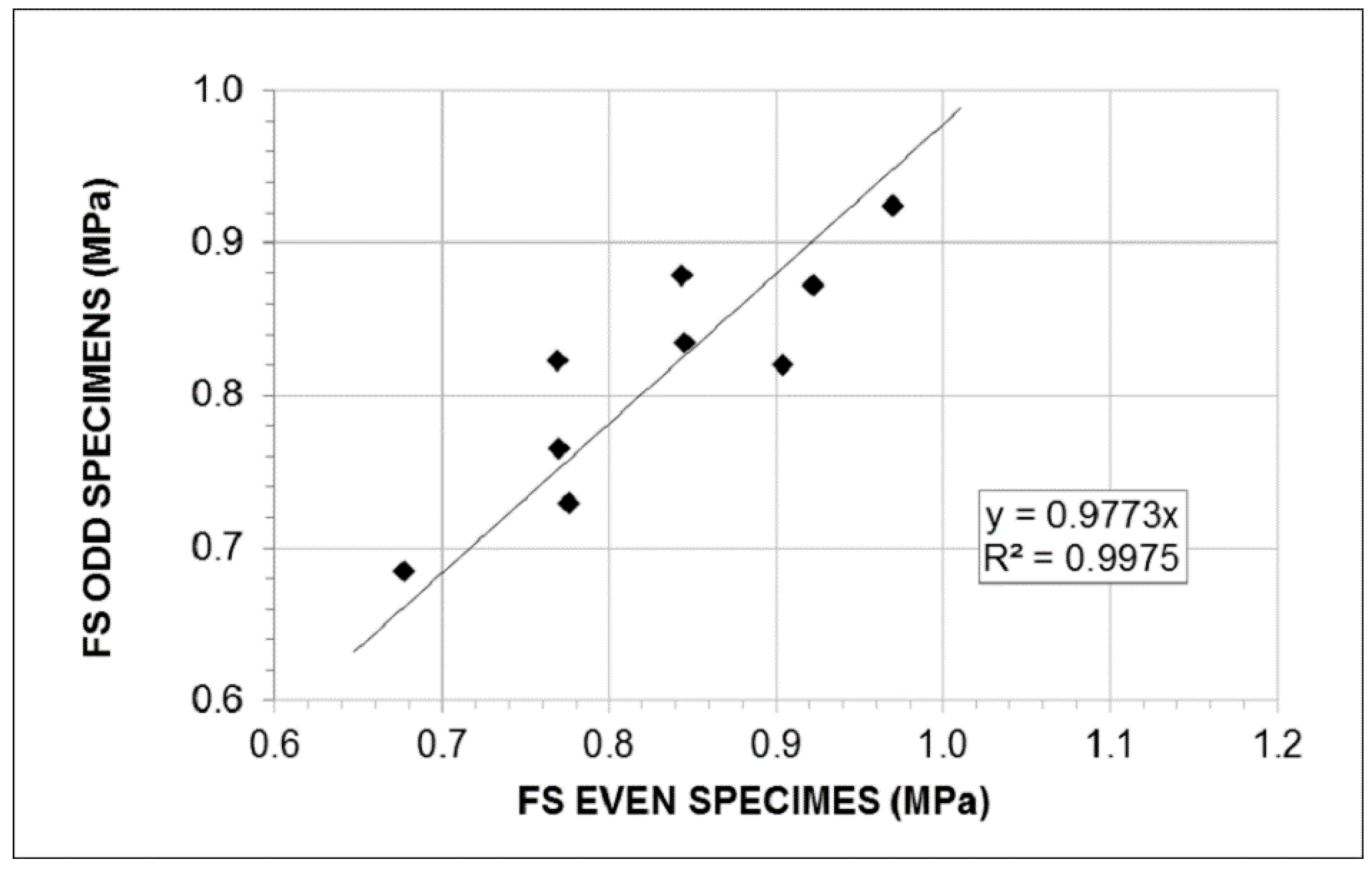
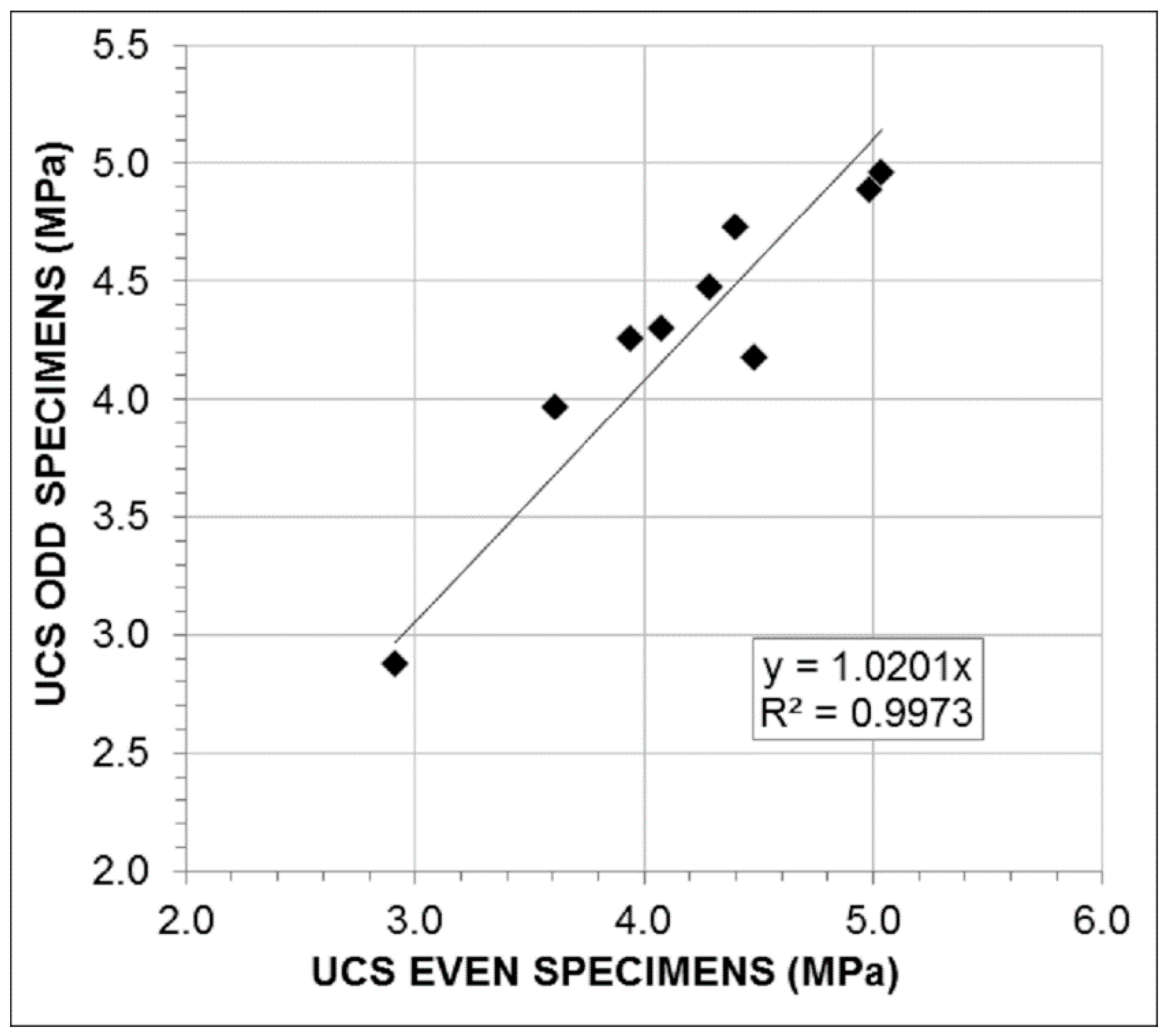

| Main Standardized Component | Value | Cement Standardized Specifications | Value |
|---|---|---|---|
| Clinker (K) | 45–64% | Sulphate | ≤3.5% |
| Silica fumes (D) * | -- | Initial setting time | ≥75 min |
| Natural pozzolana (P) * | -- | Final setting time | ≤720 min |
| Calcined natural puzzolana (Q) * | -- | Expansion | ≤10 mm |
| Siliceous fly ash (V) * | 36–55% | UCS at 7 days | ≥16 MPa |
| Calcareous fly ash (W) * | -- | UCS at 28 days | 32.5 ≤ R ≤ 52.5 MPa |
| Minority components | 0–5% | Puzzolanicity | 8 to 15 days |
| Chlorides | ≤0.10% |
| Country | UCS at 7 Days (MPa) |
|---|---|
| Spain [43] | 2.5/2.1 1 |
| United Kingdom [51] | CBM1: 2.5–4.5 |
| Australia [52] | ≤3 |
| New Zealand [53] | ≤3 |
| South Africa [54] | C2: 2–4 |
| China [55] | 3–5 |
| Sample | % Cement | Load Application Time (s) | Number of Metallic Sheets | Dry Density (g/cm3) | Modified Proctor Density (%) | UCS of Samples “A” (MPa) | UCS of Samples “B” (MPa) | Average UCS (MPa) |
|---|---|---|---|---|---|---|---|---|
| P1 | 0.0 | 20 | 4 | 2.103 | 96.48 | - | - | - |
| P2 | 0.0 | 25 | 4 | 2.057 | 94.38 | - | - | - |
| P3 | 0.0 | 20 | 5 | 2.099 | 96.28 | - | - | - |
| P4 | 0.0 | 25 | 5 | 2.089 | 95.84 | - | - | - |
| P5 | 3.5 | 20 | 5 | 2.135 | 97.94 | 2.361 | 2.451 | 2.406 |
| P6 | 3.5 | 20 | 5 | 2.139 | 98.13 | 2.733 | 2.655 | 2.694 |
| Sample | Dry Density (g/cm3) | Modified Proctor Density (%) | FS (MPa) | Differences between Modified Proctor Densities in Samples of the Same Batch |
|---|---|---|---|---|
| A1 1 | 2.113 | 96.477 | 0.677 | 1.1 |
| A2 1 | 2.089 | 95.402 | 0.684 | |
| B1 | 2.163 | 98.753 | 0.845 | 0.4 |
| B2 | 2.172 | 99.195 | 0.835 | |
| C1 | 2.136 | 97.552 | 0.771 | 0.6 |
| C2 | 2.150 | 98.184 | 0.765 | |
| D1 | 2.196 | 100.270 | 0.844 | 1.3 |
| D2 | 2.225 | 101.598 | 0.879 | |
| E1 | 2.171 | 99.132 | 0.769 | 0.7 |
| E2 | 2.156 | 98.437 | 0.823 | |
| F1 | 2.286 | 104.380 | 1.112 | 6.4 |
| F2 | 2.146 | 97.994 | 0.940 | |
| G1 | 2.206 | 100.713 | 0.904 | 2.5 |
| G2 | 2.152 | 98.247 | 0.820 | |
| H1 | 2.219 | 101.345 | 0.923 | 0.8 |
| H2 | 2.203 | 100.586 | 0.872 | |
| I1 | 2.150 | 98.184 | 0.971 | 1.1 |
| I2 | 2.175 | 99.322 | 0.924 | |
| J1 | 2.160 | 98.626 | 0.776 | 0.8 |
| J2 | 2.142 | 97.804 | 0.729 |
| Statistical Parameter | Value | Statistical Parameter | Value |
|---|---|---|---|
| Number | 18 | Minimum value | 0.729 |
| Average | 0.861 | Maximum value | 1.112 |
| Median | 0.8445 | Inferior Quartile | 0.776 |
| Variance | 0.0086 | Superior Quartile | 0.923 |
| Standard deviation | 0.0927 | Interquartile range | 0.147 |
| Standard error | 0.02186 | Skewness | 1.050 |
| Range | 0.383 | Kurtosis | 1.781 |
| Statistical Parameter | Value |
|---|---|
| Independent term | 0 |
| Slope | 0.9773 (p-value < 0.05) |
| Correlation coefficient | 0.9987 |
| R2 | 0.9975 |
| Estimated standard error | 0.0436 |
| Mean error | 0.0352 |
| Variance analysis (Snedecor F-test) | 3164.74 (p-value < 0.05) |
| p-value of the Kolmogorov–Smirnov test for residuals | 0.9348 |
| Durbin–Watson statistical test | 1.4281 |
| Sample | Dry Density (g/cm3) | Modified Proctor Density (%) | UCS in “A” Parts (MPa) | UCS in “B” Parts (MPa) | Average UCS (MPa) |
|---|---|---|---|---|---|
| A1 1 | 2.113 | 96.477 | 2.806 | 3.022 | 2.914 |
| A2 1 | 2.089 | 95.402 | 2.916 | 2.834 | 2.875 |
| B1 | 2.163 | 98.753 | 4.330 | 4.250 | 4.290 |
| B2 | 2.172 | 99.195 | 4.645 | 4.308 | 4.476 |
| C1 | 2.136 | 97.552 | 4.224 | 3.930 | 4.077 |
| C2 | 2.150 | 98.184 | 4.264 | 4.336 | 4.300 |
| D1 | 2.196 | 100.270 | 5.030 | 5.050 | 5.040 |
| D2 | 2.225 | 101.598 | 5.043 | 4.878 | 4.960 |
| E1 | 2.171 | 99.132 | 4.028 | 3.863 | 3.946 |
| E2 | 2.156 | 98.437 | 4.230 | 4.275 | 4.252 |
| F1 | 2.286 | 104.380 | 4.715 | 4.108 | 4.411 |
| F2 | 2.146 | 97.994 | 3.983 | 3.904 | 3.948 |
| G1 | 2.206 | 100.713 | 4.469 | 4.500 | 4.484 |
| G2 | 2.152 | 98.247 | 4.005 | 4.348 | 4.176 |
| H1 | 2.219 | 101.345 | 4.186 | 4.613 | 4.399 |
| H2 | 2.203 | 100.586 | 4.820 | 4.640 | 4.730 |
| I1 | 2.150 | 98.184 | 5.262 | 4.705 | 4.984 |
| I2 | 2.175 | 99.322 | 5.136 | 4.635 | 4.885 |
| J1 | 2.160 | 98.626 | 3.640 | 3.590 | 3.615 |
| J2 | 2.142 | 97.804 | 4.235 | 3.693 | 3.964 |
| Statistical Parameter | Value | Statistical Parameter | Value |
|---|---|---|---|
| Number | 36 | Minimum value | 3.590 |
| Average | 4.384 | Maximum value | 5.262 |
| Median | 4.319 | Inferior Quartile | 4.068 |
| Variance | 0.188 | Superior Quartile | 4.675 |
| Standard deviation | 0.434 | Interquartile range | 0.607 |
| Standard error | 0.072 | Skewness | 0.173 |
| Range | 1.607 | Kurtosis | −0.618 |
| Statistical Parameter | Value |
|---|---|
| Independent term | 0 |
| Slope | 1.0201 (p-value < 0.05) |
| Correlation coefficient | 0.9986 |
| R2 | 0.9973 |
| Estimated standard error | 0.2390 |
| Mean error | 0.2070 |
| Variance analysis (Snedecor F-test) | 2947.88 (p-value < 0.05) |
| p-value of the Kolmogorov–Smirnov test for residuals | 0.8695 |
| Durbin–Watson statistical test | 3.3542 |
| Statistical Parameter | Odd Specimens Value | Even Specimens Value |
|---|---|---|
| Independent term | 0 | 0 |
| Slope | 0.970 (p-value < 0.05) | 0.9643 (p-value < 0.05 |
| Correlation coefficient | 0.9976 | 0.9983 |
| R2 | 0.9951 | 0.9966 |
| Estimated standard error | 0.3098 | 0.2609 |
| Mean error | 0.2374 | 0.1894 |
| Variance analysis (Snedecor F-test) | 1829.74 (p-value < 0.05) | 2610.00 (p-value < 0.05) |
| p-value of the Kolmogorov–Smirnov test | 0.9928 | 0.9357 |
| Durbin–Watson statistical test | 2.4445 | 1.3253 |
| Author | Equation | Introduced Value | Estimated Value |
|---|---|---|---|
| Kersten [33] | (1) | UCS = 4.38 MPa | FS = 0.88 MPa |
| IECA-CEDEX [2] | (1) | UCS = 4.38 MPa | FS = 0.88 MPa |
| (2) | FS = 1.10 MPa | ||
| Lim and Zollinger [35] | (1) | UCS = 4.38 MPa | FS = 0.88 MPa |
| (2) | FS = 1.10 MPa | ||
| Linares [39] | (3) | UCS(7) = 2.55 MPa | UCS(28) = 3.81 MPa |
| Lim and Zollinger [35] | (4) | UCS(28) = 3.81 MPa | UCS(90) = 4.11 MPa |
© 2018 by the authors. Licensee MDPI, Basel, Switzerland. This article is an open access article distributed under the terms and conditions of the Creative Commons Attribution (CC BY) license (http://creativecommons.org/licenses/by/4.0/).
Share and Cite
Linares-Unamunzaga, A.; Gonzalo-Orden, H.; Minguela, J.D.; Pérez-Acebo, H. New Procedure for Compacting Prismatic Specimens of Cement-Treated Base Materials. Appl. Sci. 2018, 8, 970. https://doi.org/10.3390/app8060970
Linares-Unamunzaga A, Gonzalo-Orden H, Minguela JD, Pérez-Acebo H. New Procedure for Compacting Prismatic Specimens of Cement-Treated Base Materials. Applied Sciences. 2018; 8(6):970. https://doi.org/10.3390/app8060970
Chicago/Turabian StyleLinares-Unamunzaga, Alaitz, Hernán Gonzalo-Orden, Jesús Díaz Minguela, and Heriberto Pérez-Acebo. 2018. "New Procedure for Compacting Prismatic Specimens of Cement-Treated Base Materials" Applied Sciences 8, no. 6: 970. https://doi.org/10.3390/app8060970






